El Banco de Tamaulipas
After the Ley General, between 1899 and 1902, there were three attempts to obtain the concession for a bank of issue in Tamaulipas. The first was headed by a group of English investors with business in TampicoCEHM, letter Demetrio Salazar to José Yves Limantour, Mexico City, 29 December 1899 and the second was by the American businessman, Melitón Cross, of Matamoros and the hacendado Rómulo Cuéllar, of San FernandoA reason for the failure was the drought that afflicted the north of the state and consequent loss of income and lack of capital (CEHM, Colección José Y. Limatour, CDLIV.2a.1901 carpeta16, legajo 26341, letter Melitón H. Cross, Matamoros to J. M. Zevada Baldenebro, Mexico City, 4 June 1901 but both were unsuccessful. However, by 1902 some businessmen from Tampico and Tula and the governor, Pedro Argüelles, were convinced that a bank would stimulate the local economy. The new promoters were Tomás Ugarte, shareholder and manager of the casa comercial Ugarte y Jáuregui; Gerónimo Bergán, owner of the casa de comisiones Federico Stussy Sucs, both from Tampico, and Juan José Castaños, from Tula, a town in the southeast of the stateCEHM. letter Guillermo Obregón to José Ives Limantour, Mexico City, 28 February 1902. At the time these agencies performed a prominent role in intermediation, storage and chartering of the goods and later a wide range of activities and customer services: and represented companies of international steamers, commission agent, stevedor, freight contractor, deposit for coal, coke and cement, cargo storekeeper in transit through Tampico, and representative of maritime and land insurance companies and firefighting.
Governor Argüelles as a companion in arms of President Díaz and friend of Limantour helped authorise the concession of 26 March 1902. The founding document and statutes were signed on 25 June and the bank started business on 15 OctoberLa Voz de México, 17 October 1902.
Originally the bank had a capital of $1,000,000 but four years after its opening Guillermo Obregón solicited Limantour to increase it to $2,500,000CEHM, letter Guillermo Obregón to José Yves Limantour, Mexico City, 20 November 1906.
American Bank Note Company print runs
The American Bank Note Company produced the following notes. The company engraved special vignettes of Guadalupe Obregón (C 251)Guadalupe Obregón was the daughter of Guillermo Obregón. Her portrait also appears on the $10 note of the Banco de Querétaro as her father was also an investor in that bank., for the $5 note, of Juan José de la GarzaJuan José de la Garza Galván was born in Cruillas, Tamaulipas on 6 May 1826. He was governor of the state on eight occasions, from 1852 to 1869 and as a liberal, fought for Juárez and against the French intervention, being named General en Jefe of the Ejército Republicano. Later he served as a minister of justice and government plentipotenciary in El Salvador and Guatamala.
He died in Mexico City on 16 October 1893. (C 254) for the $500 note and the arms of Tampico (C 847) for all the reversesFive years after the founding of Tampico, the State Congress, in decree núm. 82 of 24 November 1828, granted the city its own coat of arms. The name "Tampico" is of Huastec origin, tam-piko, and means “place of dogs” so the shield included two dogs. However, otters (nutrias) are known as water dogs and would be more likely candidates so in 1973 the local Chamber of Commerce asked for the shield to be modified, in clarification, to represent “a river, some hills, some palm trees and a star of hope, a canoe in the river paddled by an Indian and on the opposite bank, two water dogs or otters (un río, unas colinas, unas palmeras y una estrella de la esperanza, una canoa en el río conducida por un indio y en la orilla opuesta, dos perros de agua o nutrias)”..
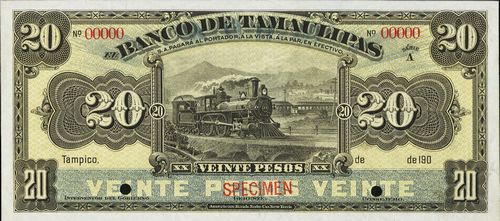
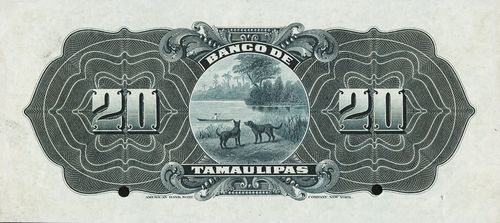 M522s $20 Banco de Tamaulipas specimen
M522s $20 Banco de Tamaulipas specimen
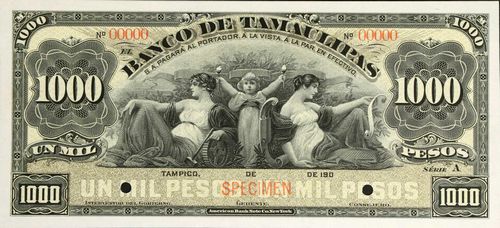
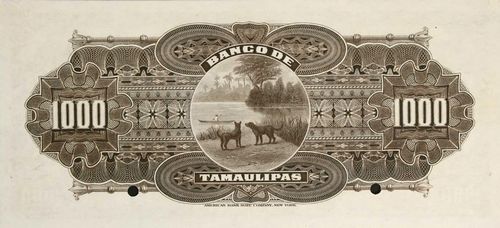 M526s $1,000 Banco de Tamaulipas specimen
M526s $1,000 Banco de Tamaulipas specimen
| Date | Value | Number | Series | from | to |
| May 1902 | $5 | 40,000 | A | 1 | 20000 |
| B | 1 | 20000 | |||
| $10 | 20,000 | A | 1 | 10000 | |
| B | 1 | 10000 | |||
| $20 | 10,000 | A | 1 | 5000 | |
| B | 1 | 5000 | |||
| $50 | 2,000 | A | 1 | 1000 | |
| B | 1 | 1000 | |||
| $100 | 1,000 | A | 1 | 500 | |
| B | 1 | 500 | |||
| $500 | 200 | A | 1 | 100 | |
| B | 1 | 100 | |||
| $1000 | 100 | A | 1 | 50 | |
| B | 1 | 50 |
| Date | Value | Number | Series | from | to |
| March 1903 | $5 | 10,000 | C | 1 | 5000 |
| D | 1 | 5000 | |||
| $10 | 5,000 | C | 1 | 2500 | |
| D | 1 | 2500 | |||
| $20 | 5,000 | C | 1 | 2500 | |
| D | 1 | 2500 | |||
| $50 | 4,000 | C | 1 | 2000 | |
| D | 1 | 2000 | |||
| $100 | 4,500 | C | 1 | 2,250 | |
| D | 1 | 2,250 | |||
| $500 | 200 | C | 1 | 100 | |
| D | 1 | 100 | |||
| $1000 | 50 | C | 1 | 25 | |
| D | 1 | 25 |
In May 1903 it was suggested that some criminals had put counterfeit notes into circulation. This was false. What had happened was that a visitor to Mexico City lost $700 in brand new Banco de Tamaulipas notes. He reported this to the police who told some casas de comercio to report anyone offering Banco de Tamaulipas notes. One policemen said this was because there were counterfeits, and this was picked up by a reporter. In fact the stolen notes were recoveredEl Tiempo, México, 28 May 1903. However, this canard was still publishedEl Correo de Chihuahua, 414, 2 June 1903.
On 3 February 1911 the bank asked for prices for 50,000 and 35,000 $5 notes, and for 50,000 and 25,000 $10 notesABNC, folder 208, Banco de Tamaulipas (1911-1932). On 21 February the bank accepted the quote for 50,000 $5 and 25,000 $10, though it asked the ABNC to use a better quality of paper on the $5 notes than previously, as these notes were almost totally destroyed. On 7 March it gave the numeration as E 1-50000 for the $5 and E 1-25000 for the $10, and on 22 March said that it had decided to have the date and signatures printed in Mexico City, so the dateline should be just “Tampico.”
| Date | Value | Number | Series | from | to |
| March 1911 | $5 | 50,000 | E | 1 | 50000 |
| $10 | 25,000 | E | 1 | 25000 |
On 25 April the ABNC, after completing about half of the $5 notes, noted a crack in the plate, that was opening so badly that they would have to stop printing and make a new plate. So the delivery was delayed until July. On 18 July the ABNC forwarded, by Wells Fargo Express, to Guillermo Obregón, in Mexico City, a box containing the 50,000 $5 (E 1-50000) and 25,000 $10 (E 1-25000).
On 12 September 1912 the bank wrote that “owing to the enormous increase in our business lately we have had to decide to increase the quantity of our notes, and we are urgently in need of them so as to accommodate our customers as much as possible, - therefore, we beg to order of you herewith the printing of 85,800 banknotes, to be the same as the previous ones furnished, which will amount to $1,000,000.” It said that it wanted the notes, in Series F, to be numbered from 1 to 85800, but this was a mistake and corrected on 24 September.
| Date | Value | Number | Series | from | to |
| September 1912 | $5 | 60,000 | F | 1 | 60000 |
| $10 | 20,000 | F | 1 | 20000 | |
| $20 | 2,500 | F | 1 | 2500 | |
| $50 | 1,000 | F | 1 | 1000 | |
| $100 | 2,000 | F | 1 | 2000 | |
| $500 | 200 | F | 1 | 200 | |
| $1000 | 100 | F | 1 | 100 |
On 27 December 1912 the ABNC consigned to the bank, in Tampico, a box containing 10,000 $5 (F 1-10000), 20,000 $10 (F 1-20000), 2,500 $20 (F 1-2500), 1,000 $50 (F 1-1000), 2,000 $100 (F 1-2000), 200 $500 (F 1-200) and 100 $1,000 (F 1-100). On 5 January 1913 it completed the order with the remaining 50,000 $5 (F 10001-60000).
On 25 November 1913 Charles Blackmore, the ABNC's Resident Agent in Mexico City, reported that there was a possibility that the Banco de Tamaulipas would issue low-denomination notes, but on 10 December he wrote that the bank had not yet received the necessary authorization from the Secretaría de Hacienda to issue notes of one and two peso denominations. They hoped to receive the necessary authorization during the coming week and had promised to give Blackmore the order as soon as they are allowed to issue small denomination notes.
On 10 January 1914 the bank ordered another $1,000,000 in notes in seven denominations, with the promise to duplicate this order if the ABNC made a sufficient reduction in its price. On 15 January the ABNC offered a discount of 12½% and on 16 January the bank doubled its order, the first set of notes to be series G, dated 31 March 1914, and the second series H, without date.
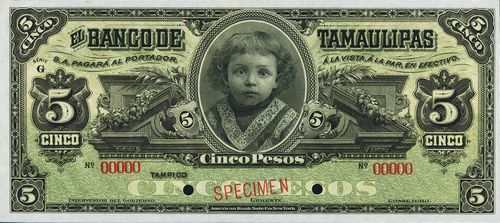
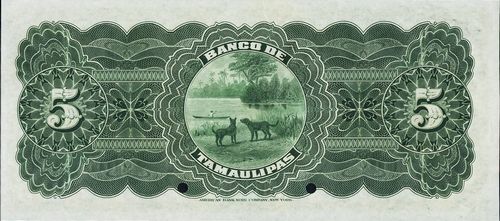 M520s $5 Banco de Tamaulipas specimen
M520s $5 Banco de Tamaulipas specimen
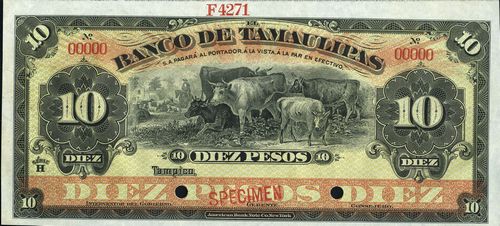
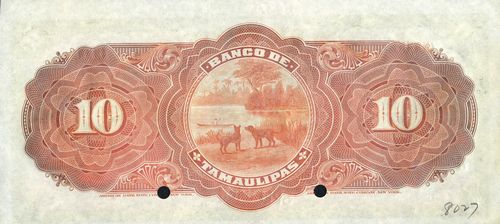 M521s $10 Banco de Tamaulipas specimen
M521s $10 Banco de Tamaulipas specimen
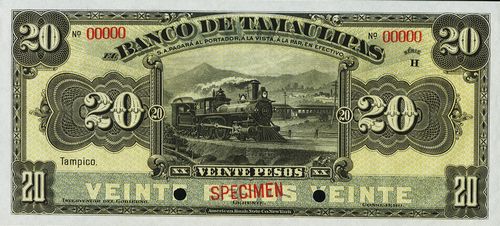
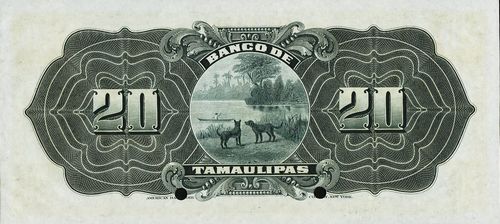 M522s $20 Banco de Tamaulipas specimen
M522s $20 Banco de Tamaulipas specimen
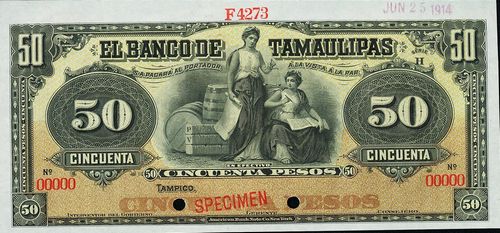
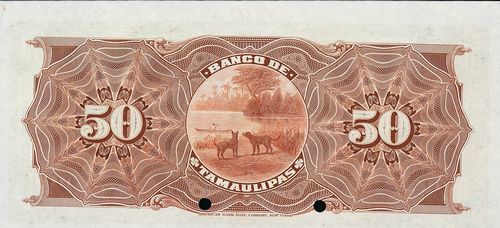 M523s $50 Banco de Tamaulipas specimen
M523s $50 Banco de Tamaulipas specimen
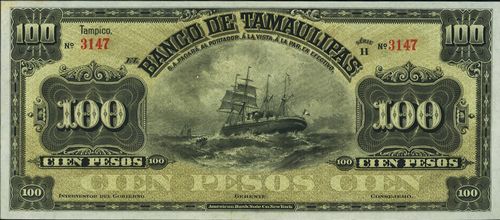
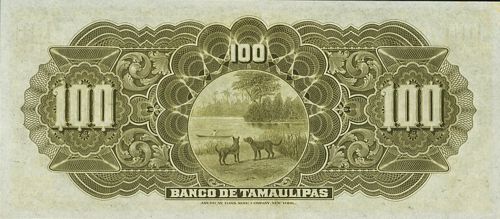 M524s $100 Banco de Tamaulipas specimen
M524s $100 Banco de Tamaulipas specimen
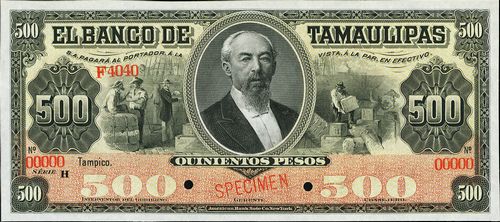
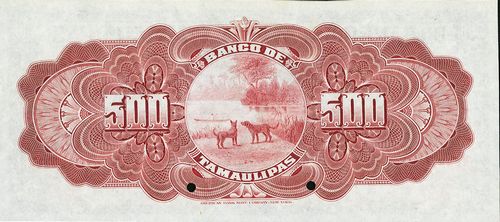 M525s $500 Banco de Tamaulipas specimen
M525s $500 Banco de Tamaulipas specimen
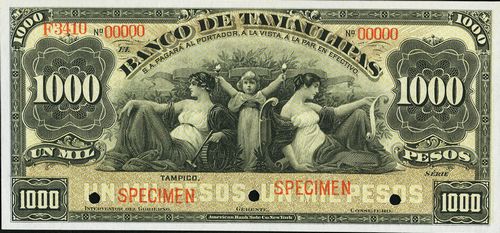
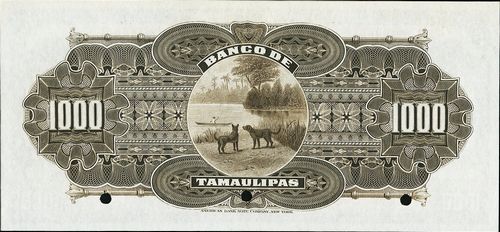 M526s $1,000 Banco de Tamaulipas specimen
M526s $1,000 Banco de Tamaulipas specimen
| Date | Value | Number | Series | from | to |
| January 1914 | $5 | 120,000 | G | 1 | 60000 |
| H | 60001 | 120000 | |||
| $10 | 20,000 | G | 1 | 10000 | |
| H | 10001 | 20000 | |||
| $20 | 10,000 | G | 1 | 5000 | |
| H | 5001 | 10000 | |||
| $50 | 8,000 | G | 1 | 4000 | |
| H | 4001 | 8000 | |||
| $100 | 2,000 | G | 1 | 1000 | |
| H | 1001 | 2000 | |||
| $500 | 400 | G | 1 | 200 | |
| H | 201 | 400 | |||
| $1000 | 200 | G | 1 | 100 | |
| H | 1 | 100 |
The ABNC forwarded these notes in a series of consignments. On 5 February 1914 it forwarded, by Wells Fargo Express, per S.S. “Esperanza” to Guillermo Busing & Cia., Sucrs., Veracruz, a box containing 8,000 $50 (G 1-4000 and H 4001-8000), 2,000 $100 (G 1-1000 and H 1001-2000), 400 $500 (G 1-200 and H 201-400) and 200 $1,000 (G 1-100 and H 101-200). On 11 February it forwarded, via S. S. “Mexico”, a box containing 33,000 $5 (G 1-33000) and 10,000 $20 (G 1-5000 and H 5001-10000). On 5 March it sent, per the steamer “Esperanza”, 27,000 $5 (G 33001-60000) and 10,000 $10 (H 1-10000) and on 12 March, per the steamer “Mexico”, 60,000 $5 (H 60001-120000). On 12 June it completed the order by shipping, on the S. S. “Kotonia” 10,000 $10 (10001-20000), received by the branch of the Banco Nacional de México in Veracruz by 21 July.
On 2 March the ABNC had told the bank that it had, by mistake, printed all 20,000 $10 notes with the series G and date. It asked whether the bank would accept the last 10,000 with wrong series letter and date or wanted them reprinted at the company’s expense. The ABNC therefore reprinted the notes with the correct series.
On 30 June the bank confirmed a new order for $5 to $100 notes, all series H and continuing the previous numbering.
| Date | Value | Number | Series | from | to |
| June 1914 | $5 | 100,000 | H | 120001 | 220000 |
| $10 | 30,000 | H | 20001 | 50000 | |
| $20 | 10,000 | H | 10001 | 20000 | |
| $50 | 6,000 | H | 8001 | 14000 | |
| $100 | 2,000 | H | 2001 | 4000 |
On 13 August the ABNC forwarded by Wells Fargo Express, per S.S. “Morro Castle”, two boxes containing 40,000 $5 (H 120001-160000), 30,000 $10 (H 20001-50000), 10,000 $20 (H 10001-20000) 6,000 $50 (H 8001-14000) and 2,000 $100 (H 2001-4000), received in Veracruz by 9 September, and on 20 August completed the order, per S.S. “Monterey”, with 60,000 $5 (H 160001-220000).
The surviving plates used in printing the notes were destroyed by the ABNC on 17 July 1931The plates were:
1 – 6 on $5 face plate #2 made on order No F 2839
1 – 6 on $5 face plate #3 made on order No F 4037
2 – 6 on $5 face plates nos. 4 & 5 made on order No. F 4270
1 – 6 on $5 back plate #2 made on order No F 3407
1 – 6 on $5 back plate #3 made on order No F 4270
1 – 4 on $10 face plate made on order No F 60
1 – 4 on $10 back plate #2 made on order No F 4271
1 – 4 on $20 face plate made on order No F 60
1 – 4 on $20 back plate made on order No F 60
1 – 2 on $50 face plate made on order No F 60
1 – 2 on $50 back plate #2 made on order No. F 3409
1 – 1 on $100 face plate made on order No F 60
1 – 1 on $100 back plate made on order No F 60
1 – 1 on $500 face plate made on order No F 60
1 – 1 on $500 back plate made on order No F 60
1 – 1 on $1000 face plate made on order No F 60
1 – 1 on $1000 back plate made on order No F 60
2 – 1 on 5 pesos tints Nos. 1 & 2 made on order No. F 60
2 – 1 on 10 pesos tints Nos. 1 & 2 made on order No. F 60
2 – 1 on 20 pesos tints Nos. 1 & 2 made on order No. F 60
2 – 1 on 50 pesos tints Nos. 1 & 2 made on order No. F 60
2 – 1 on 100 pesos tints Nos. 1 & 2 made on order No. F 60
2 – 1 on 500 pesos tints Nos. 1 & 2 made on order No. F 60
2 – 1 on 1000 pesos tints Nos. 1 & 2 made on order No. F 60
(ABNC, folder 208, Banco de Tamaulipas (1911-1932)).
On 15 February 1914 General Pablo González, in Matamoros, prohibited the circulation of any Mexican banknotes under pain of a fine or corporal punishment Periódico Oficial, Tomo XXXIX, Núm. 14, 18 February 1914. Two days later Tamaulipas’ governor, Luis Caballero, offered holders the chance to exchange their notes for Constitutionalist currencyibid.. On 19 February, Caballero, noting that the period conceded by Carranza on 6 December has expired, took over the agencies of the Banco Nacional de México, Banco de Tamaulipas, Banco de Nuevo León and Banco Mercantil de Monterrey in Ciudad VictoriaPeriódico Oficial, Tomo XXXIX, Núm. 15, 21 February 1914.
On 4 June 1914 Caballero prohibited the circulation of all banknotes dated after 23 February 1913. Holders could hang on to their notes until the banks resumed their operations and took responsibility for these issues Periódico Oficial, Tomo XXXIX, Núm. 48, 17 June 1914; SD papers, 812.516/94. On 22 June the Jefe de Armas added that people did not have to repay any outstanding debts until the banks had regularised their positionPeriódico Oficial, Tomo XXXIX, Núm. 50, 24 June 1914. However, once he had assumed power, Carranza reversed his prohibition and allowed federal offices to accept banknotes whilst ordering an examination into the conduct of the banksPeriódico Oficial, Tomo XXXIX, Núm. 71, 5 September 1914.
On 19 December 1915 Carranza's Comisión Reguladora e Inspectora de Instituciones de Crédito ruled that the bank was in breach of its concession and declared it insolvent.
The bank was finally liquidated in 1933.
